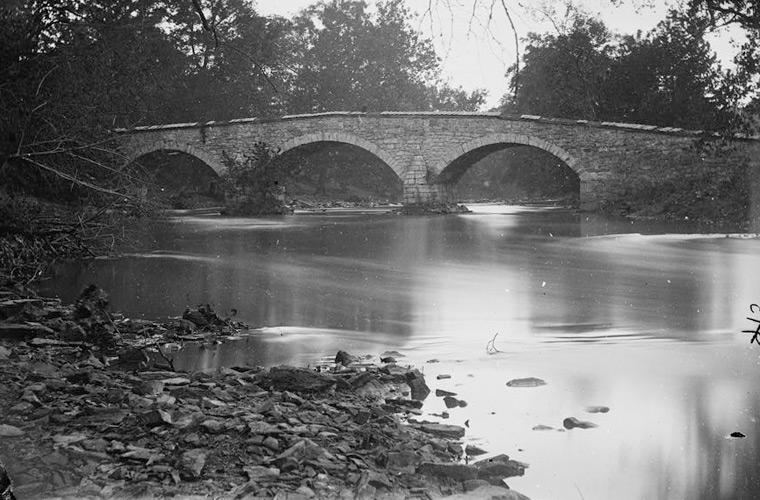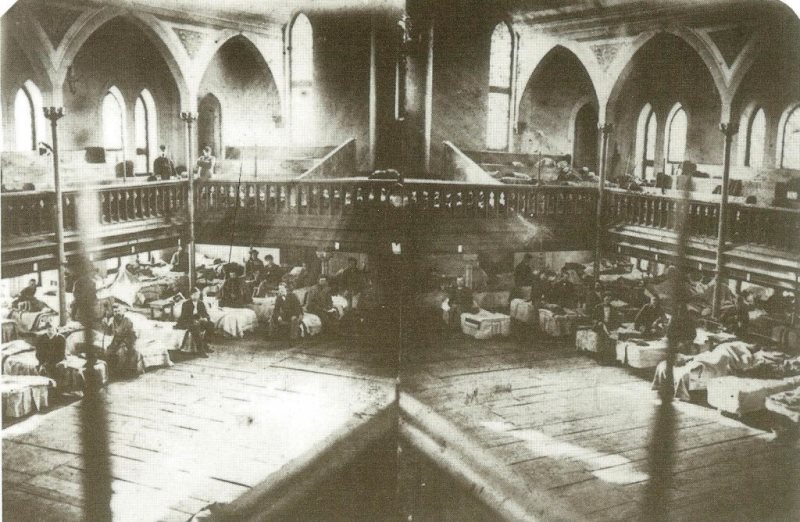Memorial Day, the day Americans set aside to remember those who fell in the service of the nation, is a day filled with parades, speeches and moving remembrances of the loved and lost.
The holiday, which began as “Decoration Day,” a day to literally decorate the graves, emerged out of the harrowing wake of the Civil War. In cities and towns across the nation, men and women gathered to remember the tremendous cost of that war – and every succeeding generation has done the same to recognize those lost in the conflicts which have followed.
In Maryland, some of the state’s most iconic landscapes and historic buildings speak to the sacrifice of the American soldier and the essential meaning of Memorial Day.
Antietam: A Landscape turned red

Burnside Bridge in 1862, Antietam National Battlefield.
Near Sharpsburg, Maryland in Washington County, the Battle of Antietam left thousands dead. In the end, Antietam is still remembered as the single bloodiest day in the nation’s history. The landscape, now serene and picturesque was a nightmarish scene when the sun finally set on September 17, 1862. Union Major General Joseph Hooker poetically recorded the description that night,
In the time that I am writing every stalk of corn in the northern and greater part of the field was cut as closely as could have been done with a knife, and the slain lay in rows precisely as they had stood in their ranks a few moments before. It was never my fortune to witness a more bloody, dismal battlefield.
Today, Antietam’s landscape speaks directly to the true cost of Memorial Day. The battlefield itself is a final resting place for unknown and unrecovered dead – it is a place where the ultimate sacrifice was made. In the wake of the bloodshed, it was a battle which then provided President Lincoln with the opportunity to issue a preliminary Emancipation Proclamation; giving a higher purpose and meaning to the sacrifice.
surviving combat: Maryland’s battlefield hospitals

Frederick’s Evangelical Lutheran Church with hospital patients, 1862.
Across the four Aprils’ of the Civil War, Maryland stood at the crossroads of history. From the earliest conflicts on Pratt Street in Baltimore to the Assassination of Abraham Lincoln, the Old Line State played a critical role in the history of the war. When actual combat occurred on Maryland’s soil, the impact was not only felt on the battlefield itself – but also in the nearby towns, villages and cities where hospitals were quickly established in whatever buildings could be requisitioned.
Following the Battle of Antietam, Frederick, Maryland became “One vast hospital.” By September 30, there were more than 2,000 patients recuperating across the City of Frederick. In public buildings and churches, many of which stand today, the veterans of Antietam recovered – and also tragically lost their fight, becoming yet another casualty of combat. Stephen Bogardus, Jr., a Union soldier assigned to Frederick, wrote to his local newspaper a fitting account of what he saw in Frederick after Antietam,
The bandaged head, the empty sleeve, and the stump of a leg, told a tale louder than words could speak,” he continued in his letter to the Poughkeepsie Daily Eagle. “Those who spoke flippantly of patriotism as a mere word should have seen some of those that I have met.
Today, these buildings in Frederick, and communities across the county, speak to the aftermath of battle and are physical reminders of the cost of Memorial Day.
a final resting place: Maryland’s national cemeteries

Unknown Dead image via Library of Congress
Beyond the bloodshed of the Civil War, Maryland is also home to four national cemeteries managed by the United States Department of Veterans Affairs: Annapolis, Baltimore, Loudon Park, and Point Lookout. Buried within the hallowed acres of these cemeteries are many of Maryland’s sons and daughters lost in combat since the Civil War.
Of Maryland’s four national cemeteries, Loudon Park Cemetery is the oldest and was one of the 14 original national cemeteries established under the National Cemetery Act of July 17, 1862. It originally served as a final resting place for soldiers recuperating in Baltimore hospitals from the nearby battles at Antietam, Gettysburg, and Monocacy.

